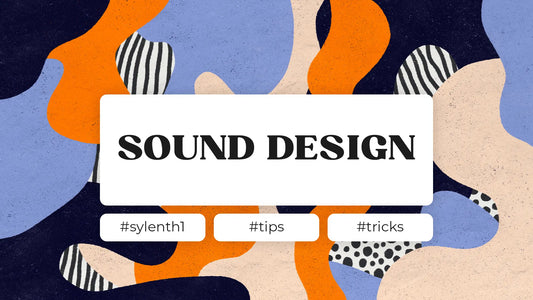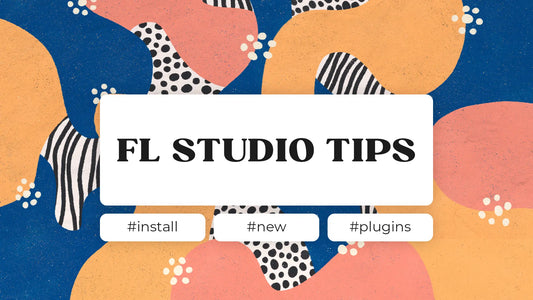This article includes affiliate links. I earn a commission if you make a purchase.
If your journey as an electronic music producer began in the 2010s, the word "Sylenth1" should definitely ring a bell.
This amazing soft synth VST has been a faithful studio tool for many EDM producers, including Martin Garrix, Avicii (RIP), and Afrojack.
The analog-emulated sound LennarDigital packed into the powerful Sylenth1 synth still holds up to today’s standards (if you ask me!)
I love the sound, the ease of use, and the broad preset libraries - they each have an iconic character.
Anyway, in this blog post, I’ll show you 10 sound design tips in Sylenth1 that you should try.
Ready? Let’s go!

1. Get LoFi vibes with the Bitcrusher
If you love LoFi, wear, and tear on your sounds, the Bitcrusher is your friend!
In the Distortion menu, you can choose the Bitcrusher mode.
You now have the power to go full mayhem and recreate an “8-bit early computer” sound - or simply add a tad of “LoFi” grit.
With two settings (Amount and Dry/Wet), it’s pretty straightforward to achieve some interesting results.
I like to crank up the Amount but dial back the Dry/Wet for a more subtle bit-reduction effect.

2. Random is cool - also for LFOs
Unexpected motion can catch the listener’s attention.
You should utilize the randomness from the LFOs in Sylenth1 - they offer a great deal of flexibility.
I especially like to use a random LFO on the cutoff filter for some cool filter mayhem.
Here’s how I set it up:
- Navigate to LFO 1 and set the waveform to “Random.”
- Set a slow to medium LFO rate and put it in “FREE” mode.
- Choose “Cutoff AB” as the modulation destination and turn up the amount a bit.
- Tweak the LFO gain to control how much the filter should be modulated.
Big vibes already! Get crazy with that “Random” LFO!

3. Fine-tune = analog drift?
Hardware synths have something magical about them: the oscillators go slightly out of tune.
Each note sounds a bit different in pitch.
And that’s something digital producer wizards try to emulate in soft synths.
Using fine-tuning to offset the oscillators can create subtle pitch drifting.
Analog drift, maybe?
Go to the “Fine” knob for OSC A1 and set it to +0.15. Set the “Fine” for OSC A2 to -0.15.
This will detune the oscillators and introduce that warm, analog hardware drift sound.
Sweet, sweet stuff!
TIP: Don’t settle for 0.15 - you can go much crazier with the fine-tuning!

4. Top-end shizzle with the Noise OSC
Sparkling and crispy top-end is so lovely. You know, that stuff that makes your eardrums dance.
Most synths come with a handy feature for getting this top-end shizzle: a Noise oscillator.
Sylenth1 is no exception. It includes a Noise waveform that produces white noise - perfect for adding sweet textures!
I love layering a Deadmau5-style sawtooth pluck with a bit of white noise texture.
Introduce the Noise waveform with just a little volume to add a subtle transient layer to the pluck.
Nice!
TIP: Add some modulation to the Noise OSC’s panning using an LFO set to a “random” waveform in “FREE” mode. It creates some sweet, organic panning.

5. Pitch modulation for “smacking” bass
You know those thumping 808 basses that shaped the hip-hop scene with their deep, in-your-face sound? They’re actually pretty easy to create using Sylenth1.
Here’s how I make a smacking 808 bass in Sylenth1:
- Select a sine waveform and pitch it down -1 semitone.
- Set the ADSR for the amplitude with a quick attack, maximum decay and sustain, and a bit of release to give the 808 a tail.
- Set Filter A to a 24 dB low-pass and roll off the high end. Add a bit of filter drive for some crunch.
- The fun part! Go to Mod Env 1 and slightly increase the decay. Set “Pitch AB” as the modulation destination - this creates a pitch transient for the 808.
- Turn up the modulation amount to get the desired smack/punch in your 808 bass.
TIP: Cranking up the pitch modulation can give you an almost synthesized kick drum sound. Try it out!

6. Delays don’t have to be synced
Echoing rhythms make people dance and move their bodies.
Delays play a central role in adding motion to synth melodies and basslines.
While we often reach for synced delays, unsynced ones can be a great alternative.
Sylenth1 has a built-in delay with separate left and right channels. Set these to different millisecond values (try between 200–400 ms), and use a high feedback setting to create long echoes on the input signal.
Using an unsynced delay works especially well when creating ambient house music.
Embracing unpredictability with delays can lead to interesting results.
TIP: Modulate the dry/wet amount of the delay using an LFO - try the “random” waveform. Listen to how the delay's volume flows up and down.

7. Set the Phaser frequency loose
“Who let the phaser out?”
Sorry, I couldn’t help myself.
That’s why you should modulate the phaser frequency. You can expand the sweeping effect by adding some extra LFO modulation.
If you have a synth pad playing sustained chords, this can add a great deal of sweet movement.
Navigate to the LFO section and choose “Phaser Frequency” as the modulation destination. Crank up the modulation amount and feel the motion.
TIP: Try using either a synced rate or a free-running wave - the choice is yours!

8. Dirty up the sound with Filter drive
Not everything has to sound clean and sterile - you know, too digital.
It can have some edge to it. Simply add a bit of distortion to the equation, and you’ve got something sick.
Sylenth1 has a “Drive” knob in the filter section. You can overdrive the filter signal to add some magnificent analog warmth.
For bass sounds, this filter drive beefs up the harmonics and helps the sound cut through the mix.
This might be one of my favorite Sylenth1 sound design tips (I’m almost sure, haha).

9. Use Misc for even more modulation
Unlock an expanded range of modulation possibilities in Sylenth1 under the “Misc” panel.
This is where bold sound design wizards venture out to discover (or rediscover) interesting soundscapes.
You can select “Velocity” values to modulate the filter cutoff. This is particularly cool for an analog-style Moog bass, where the low-pass filter opens up the harder you press the keyboard or the higher you set the velocity levels of the MIDI pattern.
Another cool modulation feature is to use the “Step Velocity” of the arpeggiator:
- Go to the arpeggiator and set some random values for the step sequencer - both high and low.
- Navigate to the Misc panel and select “Step Vlcty” as the modulation source.
- Choose “Distortion Amount” and crank up the mod amount to get a stepped, distorted effect.
Wicked!
TIP: Try using the arpeggiator unsynced for a more random and unpredictable modulation source.


10. Embrace the factory presets
You don’t always need to reinvent the wheel.
Sylenth1 comes with a bunch of factory presets. Some are bad, some are good. But one thing is for sure - they sound nostalgic, and you can start from there.
Pick a preset and tweak it to sound like you!
I especially like to do this for basses and pads - the filter and envelope usually get a little re-tweaking from me! ;-)
[VIDEO] Sylenth1 sound design tutorial
More useful resources:
📺 Watch my YouTube music production tutorials
📖 12 Essential Plugins for FL Studio
📖 20 Marketing tools for musicians and producers











